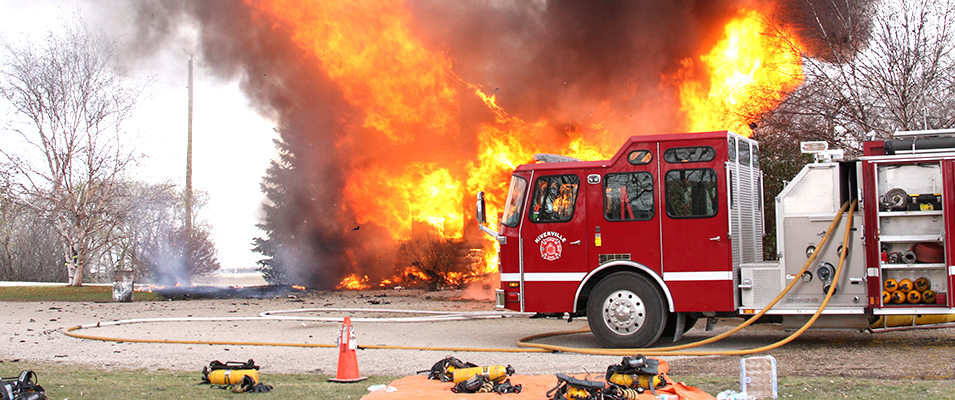
Rural residents living just outside the Town of Niverville’s boundaries on the north, south, and east sides will soon see their fire protection services change. As of January 1, 2017, the New Bothwell fire department in the RM of Hanover will be the first to be dispatched to calls in these areas.
This is not the first time Hanover has attempted to change fire services to the area surrounding Niverville, but according to residents, previous attempts were reversed after petitions were collected by affected property owners. Though Hanover’s latest decision was formally drawn up a while ago, many residents only became aware of the decision through local media sources.
“The decision was made through the Niverville annexation discussions between both municipalities back in 2013,” says Luc Lahaie, chief administrative officer (CAO) of the RM of Hanover. “Upon the release of the initial annexation proposal to the public, the annexation agreement was discussed in The Carillon and [local] radio station in [the] latter half of 2014. We understand this isn’t a popular decision, but Hanover council and administration really feel comfortable in their skin in making this decision. We are extremely confident in our fire protection abilities being the best in the province.”
The areas affected by the decision will include all property outside of Niverville’s town limits with the exception of areas west of town belonging to the Ritchot municipality. For decades prior, the RM of Hanover and Niverville worked cooperatively through a fire protection agreement allowing the Niverville fire department to respond to calls outside of town limits. Hanover compensated Niverville $12,000 per year for these services.
“The annexation agreement… included the request from Hanover to manage their own affairs in regards to fire protection,” says Niverville Mayor Myron Dyck. “Our council stated its reasons why this would not be welcomed by some residents. So, what does this mean? Simply put, the RM of Hanover was paying the Town of Niverville when it responded to certain calls. This payment will now stop as the RM of Hanover will no longer pay as of January 1. So the question was asked, ‘Let’s not worry about the money. Can’t we just go and help?’ Now we have the liability issue. If something happens on a site we do not have jurisdiction over, that means our fire service members and the town as a whole could be [held] liable and the matter of insurance and being sued comes into play. Our fire executive has stated that if they are not authorized to attend, then they simply cannot attend… due to liability issues.”
Since the time the collaborative agreement was struck between the two councils years ago, Hanover has been working to upgrade the New Bothwell fire department’s equipment and staff in preparation for this move.
“Hanover has one of the largest, best equipped, best trained, and highly skilled fire departments in the province,” says Lahaie. “We feel we can provide the same or better service as the Niverville fire department. At the annual Manitoba Association of Fire Chiefs conferences, Hanover was considered to be a leader amongst all paid volunteer fire departments.”
Lahaie adds that Hanover is currently working to create a new fire service agreement with Niverville which will come into effect at the time of the other changes.
“Under the [new] Reciprocal Fire Agreement effective January 1, [for] any large fire or MVC (motor vehicle collision), Hanover will call Niverville immediately to assist,” says Lahaie.
Fire Still Haunts Local Mother
On a crisp winter night in 1994, Terry Dowse, wife and mother of three, woke up to smoke so thick she couldn’t see her hands in front of her face. She vividly recalls her husband’s panicked voice calling to the family to wake up and get out of the house. The furnace had malfunctioned, swiftly sending smoke and flames throughout the house.
The family’s home was located on Prefontaine Road, one-quarter mile from Highway 59. Terry’s husband George made sure she and the two older boys got out safely. That’s when they realized that George Jr, just ten years old, had not come down from his upstairs bedroom. George went back inside to save his son while another son ran barefoot in minus-thirty weather to the neighbours to call 911.
That was the last time Dowse saw her husband alive. George and the youngest son succumbed to the fire before firefighters could save them. The responding fire department came from Lorette, approximately 20 kilometres from the Dowse home. Firefighters also came from Landmark, 15 kilometres away. The Niverville fire department, about seven kilometres away, was unable to respond because of the home’s location about a mile outside their municipal jurisdiction.
“I didn’t know where the [boundaries] were,” says Dowse. “I was just a mom. I worked part-time and [George] was gone a lot. People [might] have been saved if they would have been there five minutes earlier.”
Dowse understands the critical nature of response times when every moment counts in an emergency. Though she can only speculate as to whether her family’s outcome could have been different, she is appalled by municipal boundaries that separate us in times when common sense should prevail.
“We’re talking about life and death,” says Dowse. “We’re talking about a family devastated. Get your head on straight. If you’re [the] closer [fire department] you should be the ones coming. I would say to these [legislators], ‘What if it was you? What if it was your family?’”
Mayor Dyck of Niverville suggests that Manitoba’s system of municipal fire protection needs work.
“This boundary issue is not unique to Niverville. It exists all over the province,” says Dyck. “Thus, municipal leaders are engaged in discussions all over the province on how to better provide service. Some on our council like the Province of Ontario’s model where concentric circles provide the boundary and municipal boundaries are irrelevant. It is this approach our council believes makes more sense. We will need a provincial mandate, however, to implement such a system.”
How Will Hanover’s Decision Affect EMR Services?
Emergency medical responders (EMR) are often the first to respond on the scene when a medical emergency is taking place. Niverville resident Steven Cope is grateful every day for the Niverville EMR’s quick response that saved his wife’s life.
In June 2015, Maureen Cope was driving home from Winnipeg. Steven was in the passenger seat and their daughters in the rear. Just miles from the Highway 311 turnoff, Maureen had a heart attack behind the wheel and slumped over, unconscious. Thankfully, Steven had the wherewithal to take over from the passenger seat, using one hand to prop up his wife and another to apply the vehicle’s brakes. Upon getting the vehicle under control, he called 911. The operator coached him in CPR, assuring him that an ambulance had been dispatched.
Based on Cope’s phone log from that night, he estimates that the Niverville EMR were onsite within ten minutes of his call to 911. Quickly assessing her condition, first responders applied the defibrillator to her chest, shocking her heart back into action and keeping her condition steady until the ambulance arrived.
“I figure ten minutes is a pretty fantastic response time considering they were all volunteers,” says Cope. “There shouldn’t be questions as to whose jurisdiction it is, because those questions and that confusion can cost time. And in [my wife’s] case a life, because from every doctor we’ve talked to, it’s a miracle that she’s still here. She was dead. If that response time would have been an extra three or four minutes because they came from [farther away]? The human brain can only go four or five minutes without oxygen.”
According to Jim Buys, CAO of the Town of Niverville, EMR boundaries will not change with the Hanover decision. Fire and EMR services fall under different sets of rules. Fire services are governed by the Municipal Act and municipalities set their own standards. EMR services are governed by the health region and the province sets those standards.
Niverville EMR boundaries will continue to extend west of Niverville to Highway 200, north to Highway 210, south to Highway 305, and up to a short section east of Highway 59.
“Only fire service response is being amended,” says Lahaie. “EMR is not being affected as the Town of Niverville will continue providing these services to this area in Hanover, as they are also providing these services to areas in the RM of Ritchot and the RM of Tache, without Niverville fire department needing to provide fire services to those areas."
Mutual Aid Districts
The Office of the Fire Commissioner (OFC) is a provincially governed organization whose mission statement reads, “To safeguard both persons and property from fire and life safety hazards through education, investigation, emergency response and code application.”
Operating under the Municipal Act, the OFC has divided the province into 17 Mutual Aid Districts (MAD) and encourages communities across Manitoba to participate in mutual aid agreements with other fire departments within their district.
According to the OFC website, “The Mutual Aid System is a no-charge reciprocal system of emergency response and assistance that towns, villages and municipalities in southern Manitoba can access through their local fire departments. The main focus of the Mutual Aid System is to make a large number of resources available in a pre-arranged, organized fashion at no additional cost to the town, village or municipality requiring assistance during a large-scale emergency situation.”
For years, the Niverville fire department has partnered with the Eastman MAD, which includes the Ritchot municipality to the west of Niverville. Each MAD has a coordinator responsible for smooth and efficient fire responses between the participating communities. It is the coordinator’s responsibility to ensure that no participating fire department goes without backup protection in the event of an emergency.
Because participation is optional and the system is set up on a no-charge basis (MAD-participating fire departments do not charge each other for the assistance they give), some towns and municipalities choose rather to create fire protective agreements with their neighbouring municipalities and fire departments. In such cases, payment terms are negotiated.
The RM of Hanover does not belong to a MAD.
“Up until 1995, Hanover was part of Eastman Mutual Aid District,” says Lahaie. “The purpose of a provincial mutual aid system is for fire departments to provide an organized assist to each other during a large incident that would have depleted a fire department’s resources, free of charge. At that time, most municipal fire departments in Eastman were poorly equipped, poorly maintained, understaffed and poorly supported. Hanover and Steinbach were the exception and, as a result, we were providing a lot of ‘first call in’ responses outside of our municipality. Hanover ratepayers were paying for and providing much of the fire protection in the region. When Hanover council asked their neighbours to make changes and start providing more funding for their own fire departments, they instructed their fire chiefs to vote to remove Hanover and Steinbach from Eastman Mutual Aid. Since then, Hanover has paid neighbouring [municipalities] for services.”
Fire Services and House Insurance
Though fire department response time is at the top of residents’ concerns, some homeowners affected by Hanover’s decision might also expect changes to their house insurance. Licenced insurance broker Deb
Pearson says that insurance companies use three categories to determine a property’s insurance costs: whether it is hydrant-protected, semi-protected (within 13 kilometres of the responding fire department), or unprotected (more than 13 kilometres from the responding fire department).
Pearson says it is important to note that the insurance company looks at the property’s distance from the responding fire department, not the nearest fire department.
“I did a homeowner’s quote based on a house insured for $300,000 and there was a $500 difference between semi- and unprotected,” says Pearson.
Lahaie says that Hanover council has been in contact with insurance companies to verify the impact of their decision. “Insurance rates shall not change as most residences would fall within the 13 kilometres. Farms are calculated individually.”



















